Dill sauce recipes for the winter: preparing a delicious dressing with your own hands
Dill gives the dishes a special aroma and unique taste. It is used in almost any kitchen, so it is simply necessary to have dill preparations in stock in winter. Pickled greens retain useful substances, taste and aroma. Dill sauces and dressings for the winter will diversify the preparations or even become an alternative to dried dill.
The content of the article
Dill sauce recipes for the winter
For preservation, choose only fresh bunches of greens. This will make the sauce tastier and last longer.
Dill sauce for the winter: a recipe without vinegar
The simplest recipe - without any exotic and hard-to-find ingredients.
Ingredients:
- 2 large bunches of dill;
- 10 teeth garlic;
- 100 ml of vegetable oil;
- 0.5 tsp citric acid;
- salt.
Preparation:
- Chop the dill and garlic in a blender.
- Add salt, citric acid and oil.
- Mix everything thoroughly and send to a saucepan.
- Warm up, stirring constantly.
- Transfer to a jar.
Dill, garlic and lemon sauce
Light lemon sourness and garlic pungency make the taste of dill original. All ingredients can be easily mixed with a blender.
Ingredients:
- 2 bunches of dill (2 cups, chopped);
- 100 ml of sunflower oil;
- 1 lemon;
- 1 clove of garlic;
- 5 tsp lemon zest;
- 1.5 tsp salt.
Preparation:
- Rinse the dill and chop finely.
- Grind the herbs with salt.
- Grate the garlic on a fine grater.
- Add the zest and juice from the whole lemon. Mix.
- Pass the squeezed lemon through a press and add to the mass.
- Pour in sunflower oil, mix thoroughly.
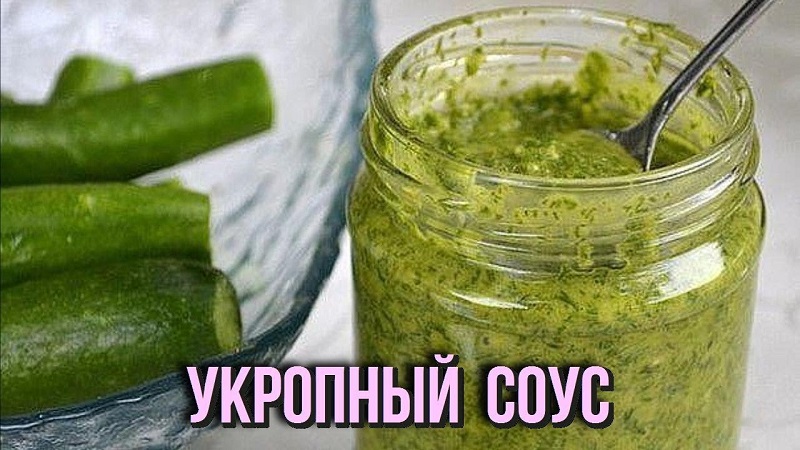
Dill dressing with carrots and garlic
Harvesting dill with carrots and garlic serves both as an addition to soups and as an independent vegetable snack.
Ingredients:
- 150 g dill;
- 600 g carrots;
- 400 g of onions;
- 10 cloves of garlic;
- 2 tbsp. l. vinegar;
- 100 ml of vegetable oil;
- 100 ml of water;
- salt to taste.
Preparation:
- Peel and chop all vegetables.
- Saute the carrots and onions in oil until golden brown.
- Add garlic, dill and salt.
- Pour in water and cook for 15 minutes.
- Add vinegar, bring to a boil and remove from heat.
- Transfer the gas station to the jar.
Dill sauce with mustard
For this recipe, it is best to take a soft, not very hot mustard. The sauce goes well with meat and fish.
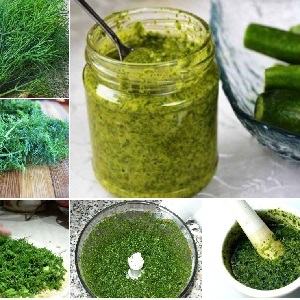 Ingredients:
Ingredients:
- 100 g of dill;
- 100 ml olive oil;
- 2 tbsp. l. mustard;
- 1 tbsp. l. wine vinegar;
- a pinch of salt.
Preparation:
- In a bowl, combine the mustard, olive oil and vinegar.
- Wash the dill and chop finely.
- Pour greens into a bowl, add salt and stir.
- Pour the sauce into the jars.
Dill sauce with horseradish
This recipe will appeal to those who prefer spicy dishes. If desired, add parsley or mint for piquancy.
Ingredients:
- 200 g of dill;
- 300 g horseradish root;
- 3 tbsp. l. apple cider vinegar;
- 2 tbsp. l. Sahara;
- 200 ml of water;
- salt to taste.
Preparation:
- Peel and chop the horseradish root.
- Chop the dill and add to the horseradish.
- Pour in sugar, salt. Add vinegar.
- Mix everything in a blender.
- Pour in water gradually until the desired consistency of the sauce is achieved.
- Pour into jars.
Dill sauce with tomato
A refreshing universal sauce with tomatoes. Suitable for pizza.
Ingredients:
- 500 g of dill;
- 800 g tomato;
- 2 tbsp. l. Sahara;
- 200 g of onions;
- 5 tbsp. l. vegetable oil;
- 1 tsp salt;
- 0.5 tsp black pepper.
Preparation:
- Wash the tomatoes, peel and chop finely.
- Peel and chop the onion.
- Combine vegetables in a saucepan. Add oil and simmer for 30 minutes.
- Wash the dill, chop. Add to hot vegetable mixture. Boil.
- Divide into banks.
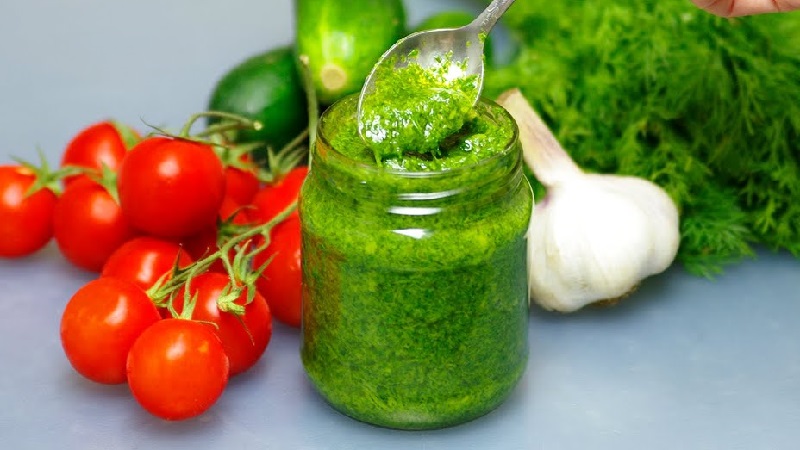
Dill stalks paste
This option even allows the use of plant stems. It should be borne in mind that this part of the dill is more astringent than the leaves.
Ingredients:
- 200 g stems;
- 10 cloves of garlic;
- 1.5 tsp salt;
- 1 tbsp. l. wine vinegar;
- 75-100 ml of vegetable oil.
Preparation:
- Grind the stems in a blender or pass 2 times through a meat grinder.
- Grate the garlic on a fine grater.
- Mix all ingredients except vinegar in a saucepan. Simmer for 15-20 minutes with a little water.
- When all the water has evaporated, add the vinegar. Bring to a boil and remove from heat.
- Transfer the paste to a storage container.
How to close dill blanks
To make a long-lasting sauce, you need a natural preservative and sterilization. Vinegar or citric acid acts as a preservative. Horseradish also does an excellent job of this.
Before placing the product in the jars, it is necessary to sterilize them. To do this, take a large saucepan and boil water in it. Put inside the jar and boil for 15-20 minutes, then unfold the workpiece and roll it up tightly. It is better to use a special seaming machine.
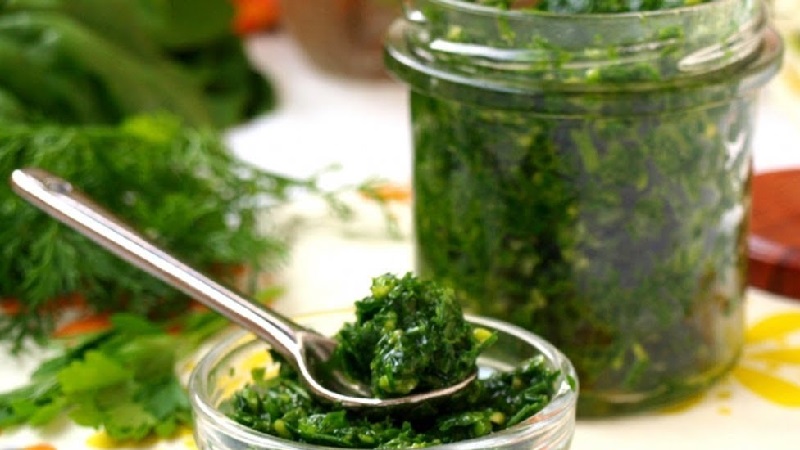
Terms and conditions of storage
Store the workpieces in a cool place. A refrigerator or cellar is considered the best place. Main storage conditions:
- Avoid direct sunlight.
- Avoid sudden temperature changes (the kitchen will not work).
- Do not expose to subzero temperatures on the balcony (this bank will flow or burst).
- Keep away from heating appliances.
If all conditions are met, the workpieces can be stored for up to 4-5 months. When using horseradish - up to 6.
Application methods
Dill blanks are great for various dishes: meat, fish, soups, vegetables, sandwiches, etc.
Dill with tomato, for example, is an excellent sauce for spreading pizza dough or adding to borscht.
Important! Since all preparations contain salt or spicy ingredients, do not add similar spices or foods to the prepared dish.
Dill sauces are also used as bread paste. Unleavened bread will take on some of the salt.
Useful Tips
Here are a few tips to help keep your workpiece fresh:
- Wash and sterilize jars with lids thoroughly before use.
- Place vegetables in jars while they are still hot.
- Choose only fresh food for preservation.
- Be sure to taste the finished dish before rolling.
- After closing the jars with lids, turn them upside down, wrap them with a blanket and leave for a day to cool slowly.
- Use only clean, dry spoons to apply the sauce.
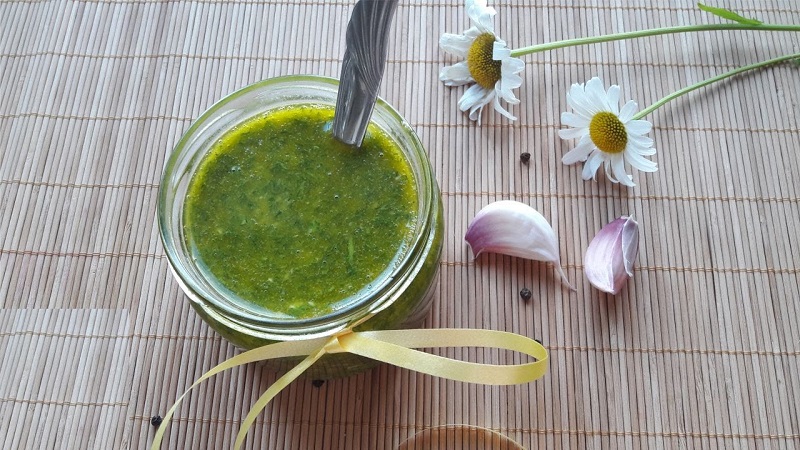
Let's sum up
Dill sauces are very simple and quick to prepare. Just 30 minutes - and a fragrant addition to soups, meat or just bread is ready. A bright green color will remind you of a warm summer in winter.